Studying the sites in the Talyanka settlement, experts came to the conclusion that the walls of the first floor of the buildings were in the form of a log cabin. As for the walls of the second floor, they were lightened – a columnar structure entwined with vines or wood chips and plastered on both sides with clay. Judging by the finds of models of houses (Trypillian settlements Kolomiyshchyna II, Rassohuvatka, Voroshilivka and others), the roofs of Trypillian houses had two slopes.
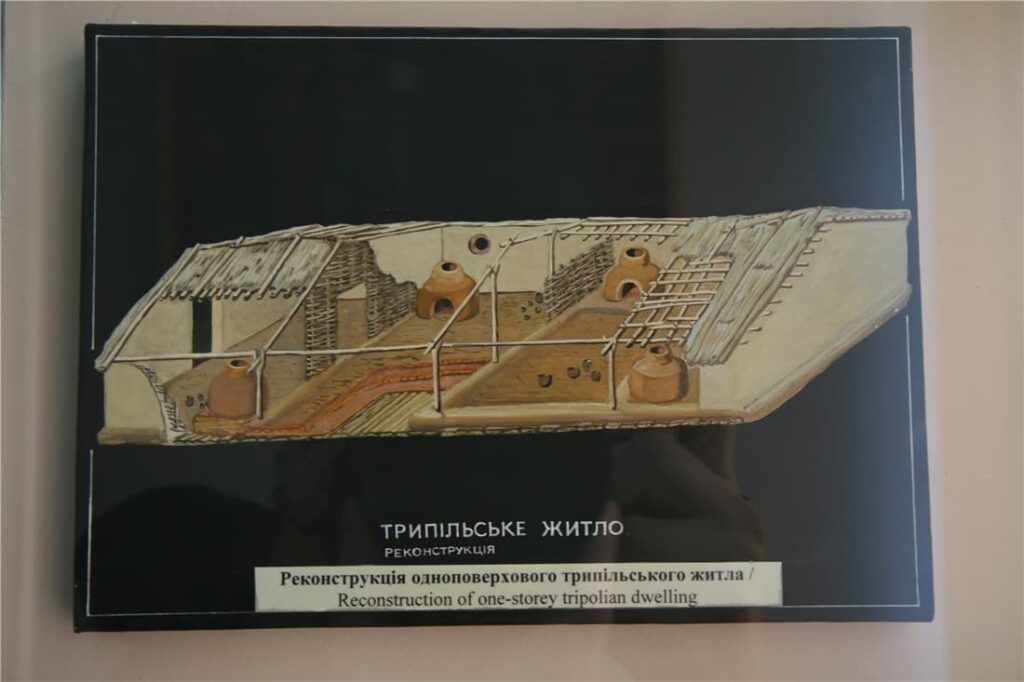
The walls, roof, and stove are clearly visible
According to excavation data, the entrance to the dwelling was located on the end side. At the level of the second floor, the entrance to the living room was preceded by walls occupying 1/4 or 1/3 of the volume of the floor. A round window was placed in the opposite wall of the entrance, which served to illuminate the room and remove smoke (if it was burning “in a simple way”). How long did it take to build such a house? If the construction was carried out by dozens of settlers, then they could invest in a period from several days to a month, depending on the number of workers and the availability of building material.
Archaeological studies indicate that great importance was attached to the arrangement of buildings. Residents painted the walls of buildings with mineral paints, of which they had a lot. Various carved wooden details were used in the household and interior, for example – dishes, plates, pots, spoons, knives, etc. The premises were heated both by open fireplaces and by stoves paved inside the house.
Сeramic models of buildings allow to reconstruct the exterior, interior and decoration of the houses and religious buildings of the people of Trypillian culture. It is important to note that the type of housing, its planning and decoration was created during the Trypillian period, which would later become a characteristic feature of the architecture of the rural population of Ukraine in the following millenniums. And agriculture, like the people of Trypillian culture, was the basis of the economic life of the population on the territory of Ukraine until the 20th century.
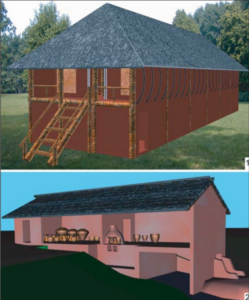
As for the interior, it was approximately the same in all dwellings. There must have been a stove in the house, which was located to the right of the entrance in the corner between the partition separating the hall from the living room and the right longitudinal wall. On both sides, it was surrounded by a steep rise. The dimensions of the furnace structure were about 2 – 2.5 m. Judging by the individual fragments, it can be imagined that it was a thick (5 – 6 cm) layer of clay, first smeared on a wooden frame, which then burned out. The stoves were made of several layers smeared with clay with an admixture of not chaff, but sand, which allows them to be clearly identified during excavations.
Under the opposite wall of the entrance, on the central axis of the house, there was a raised round shape with a diameter of 1.4 – 1.7 m, surrounded by a groove, which is interpreted as an altar. It, like black stoves, was made of clay without chaff admixture, applied in several layers, and was raised above the floor level by 10-12 cm. Its surface was carefully smoothed, and sometimes decorated with an indented ornament in the form of arc-shaped ribbons of parallel drawn lines.
Along the entire longitudinal wall (to the left of the entrance) there was a narrow elevation for placing dishes for everyday use and containers – piphos, which probably contained grain and other supplies. Under the same wall, opposite the furnace, there was a workplace – a rectangular adobe elevation with a stone grain grater on the surface.
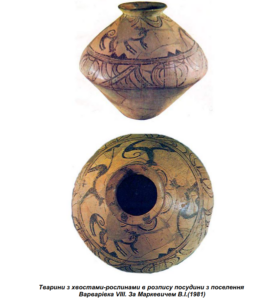

In the process of archaeological excavations, a lot of materials were obtained, which characterize various aspects of Trypillian life and testify to the high level of culture and economy of Trypillians. This is, in particular, a huge amount of ceramics, plastic depicting gods, people, animals, models of houses, temples and even vehicles (carts, sledges). Numerous tools made of flint and other rocks were found – clay, bone, horn, as well as some objects made of copper (a small four-sided awl) and metal, which makes it possible to assert the beginnings of metallurgy in the Trypillian era.
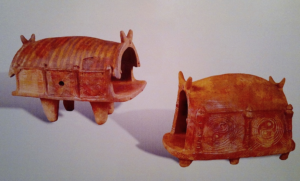
What other information about the Trypillian civilization do the results of archaeological excavations provide? There is every reason to believe that the people of Trypillian culture were extremely hardworking and creative people. Bread-making, agriculture, pottery, spinning, weaving are their main occupations. Favorable, fertile and fertile lands of ancient Ukraine gave the people of Trypillian culture the opportunity to create their paradise on earth, to develop production and the economy at full capacity.

The people of Trypillian culture “exported” grain (wheat, barley, peas, millet), food, ceramics, embroidery, jewelry, decorative objects made of wood and stone in large quantities to neighboring regions. Thanks to this, the Trypillian culture went down in history as one of the largest agrarian civilizations of mankind. The people of Trypillian culture were real breadwinners of the population, apparently not only of their own, but also of part of the population of ancient neighboring civilizations.
At that time, there were large forests and rivers near the Trypillian settlements. This allowed active hunting of animals. Men were actively engaged in: hunting for bison, deer, moose, roe deer, and wild boar. They were also engaged in fishing – catching annual fish (roach, perch, pike, eel), as well as animal husbandry – breeding goats, cows, pigs, which was facilitated by the rich meadows and pastures in the valleys of the Dnieper, Dniester, and Southern Bug. The large number of images of cats and dogs found on Tryplian pottery suggests that they probably had domesticated animals.
However, actively engaged in farming, multiplying and developing, the trypillians quickly depleted the soil and, having stayed in one place for 50-70 years, left it and moved to “fresh” lands. This, in fact, explains their settlement on a huge territory from Romania to Ukraine – here they occupied an area of 200,000 square km and left behind more than one and a half thousand settlements.
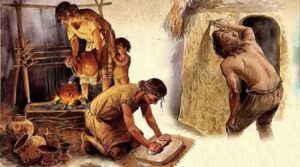
This is how the people of Trypillian achieved considerable success thanks to their own work, intelligence and resources of a very rich territory, which is now called Ukraine. They were the first to prove that you can build a high civilization and a good life here with your own hands. However, the Trypillian civilization itself later disappeared, and only at the turn of the 19th and 20th centuries it reappeared in all its glory, thanks to the research of archaeologists.
One of the most mysterious rituals practiced by the Trypilians was the burning of their settlements. When it was time to move to a new place, the fire transported their houses, filled with dishes, food supplies and other household items, along with cult paraphernalia, to another world. It is thanks to this ritual that thousands of Trypillian artifacts, left thousands of years ago in dwellings before they were given over to the fire, have survived to this day.
Having existed for fifteen thousand years, one of the centers of the spread of agriculture quickly disappeared from the historical arena, leaving behind no evidence, except for archaeological ones. Historians are still puzzled: what could have happened? Why did a large-scale civilization disappear, where? Was it a natural disaster? Economic crisis? Is there a big war between different settlements?
In fact, archaeologists tend to believe that the people of Trypillian culture did not disappear anywhere. They were simply gradually supplanted by more primitive tribes of corded ceramics, in other words, pastoralists, nomads, barbarians came and devastated the region. Some part of the Trypilians still remained in Ukraine and moved higher, to the northwest, where they hid in the caves of the Ternopil Region and, over time, probably left them and moved on or dissolved into the local population.
After some time, that part of the Trypillians appear on the historical scene again, but already as participants in the creation of the legendary Cretan-Mycenaean (Minoan) civilization. They were called Pelasgians – Lelegs – those who left the Motherland, but dream of returning.
Thus, the Trypillian heritage turned out to be quite attractive for the new communities that appeared around 2100-2500 B.C. In particular, we find the “Trypillian script” on Kamares (Crete island) and Girla-Mare (Gаrla-Mare, Danube civilization) ceramics. These were ceramic vessels and statuettes, still similar to Tryplian ones, but which gradually lost their authenticity and took on new Mediterranean features.
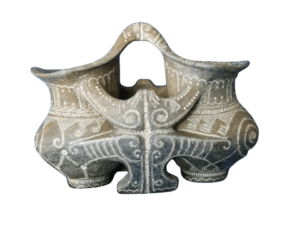
(continued)